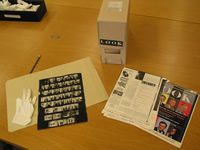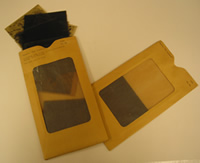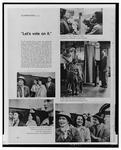Background and Scope |
Introduction
Sample contact sheet from Look magazine collection and page from a corresponding article showing the selection of photos that were published.
|
The Look Magazine Photograph Collection is the photographic archive of Look magazine. The full collection, which includes cataloged and uncataloged portions, consists of images published in Look magazine between 1937 and 1971, as well as images that the magazine never published. It totals approximately 5 million items consisting of:
- black-and-white negatives (35 mm, 120 size, 4x5 inches and 8x10 inches)
- black-and-white contact sheets
- color transparencies and slides (35 mm, 120 size, 4x5 inches and 8x10 inches).
Look was a biweekly, general interest popular magazine published from March 1937 to October 1971 by Gardner Cowles, Jr., under various company names: Look, Inc. (1937-45); Cowles Magazines (1946-65); and Cowles Communications, Inc. (1965-71). Look began as a tabloid-style magazine that emphasized sports, movie stars, and sensationalism. After World War II, it became more family oriented and included articles on social and political subjects, as well as regular features on personalities, food, fashion, and sports. Look's "golden years" (1954-64) followed improvements in the magazine's design and focus by editor Fleur Cowles, art director Alan Hurlburt, managing editor Dan Mich, and others.
The photographs reflect the wide variety of topics covered by the magazine, including:
- celebrities in many fields, especially politics, entertainment, and the arts
- food
- fashion
- lifestyles
- sports
- developments in medicine and technology
- social issues such as civil rights and women's changing roles
- international affairs.
Taken together, the published and unpublished images provide insight into the magazine's photojournalistic documentation of aspects of society and culture--particularly American society and culture--in the middle decades of the twentieth century.
Look's publisher, Cowles Communications, gave the collection to the Library of Congress in 1971, along with the archives of two related publications, Quick and Flair. Quick was a short-lived (1951-1953), pocket-sized publication for which the Library of Congress holds only a limited number of photographs. Quick photographs that also appeared in Look are cataloged with the Look material and can be distinguished by their call numbers, which include the word "Quick" (e.g., LOOK - Job 52-Quick 179). Flair materials are currently unprocessed.
The Photographers
The magazine employed a substantial number of photographers. In any one year, an average of 12 photographers worked on staff as salaried employees. Some had backgrounds in documentary photography. John Vachon and Arthur Rothstein, for example, had worked during the 1930s and 1940s for the federal government's Farm Security Administration and Office of War Information. Stanley Tretick and Tony Vaccaro had previously served as photographers in the military.
While many photographers who were hired on staff worked only for a short time for the magazine, several had long careers there, producing thousands of photographs in the course of their work. Among the most prolific were:
|
|
In addition to its cadre of staff photographers, Look employed a large number of photographers who regularly worked on a contract basis over the years. Notable among these, for instance, were Archie Lieberman and Susan Greenberg-Wood. An alphabetical list of photographers represented in the cataloged portion of the collection is available online.
The collection came with very little documentation about the photographers. Particularly in the early years of the magazine, it is not always clear on what basis photographers worked for the magazine--whether they were hired on staff and received a salary or were simply commissioned for particular jobs. Starting in about 1942, when the magazine's masthead began to include photographers, the appearance of a photographer's name in the masthead served as an indication that the individual worked on staff.
Prints & Photographs Division staff had conversations with a few former Look photographers in the course of preparing the collection. The photographers' comments about their working methods suggest that one of the perceived advantages of working for Look was that they could "pitch" promising stories to the editors. Photographers usually worked in tandem with a writer, developing a story as information unfolded, rather than following a pre-constructed shooting script. (See the Related Resources - Recorded Sound section for a list of audio interviews with Look staff and others commenting on Look in the context of American photojournalism .)
Scope of the Cataloged Material
The mammoth Look archive came to the Library of Congress in varying states of organization; some material was fairly clearly grouped and identified, other material was not. P&P staff spent ten years analyzing, organizing and cataloging the material that could most readily be served to the public, making accessible nearly four million items through ten thousand catalog records.
 Materials served in the reading room for LOOK Job 59-8405 relating to John F. Kennedy. The material served in the reading room consists of contact sheets of black-and-white photographs and photocopies of published black-and-white and color images. Catalog record for LOOK Job 59-8405 |
Certain key factors determined what material staff cataloged and how.
Key concept: the photographic "job": A "job" consists of images made for a single photo assignment, whether the images were ever published or not. Each job can include black-and-white photographs and color transparencies or slides. Images from a single job may have been used and reused in several different Look articles. One Look article may have used images from several different jobs.
Example: LOOK - Job 59-8405 consists of photographs John Vachon made of Senator John F. Kennedy and his brother, Robert F. Kennedy in 1959. Although not all of the black-and-white and color photographs were published, photographs from this job were used in fourteen Look articles between 1959 and 1967, as well as a book published in 1968 by Look.
-
Images made by Look: The cataloged material consists of images produced by photographers working for Look, either on staff or on commission. Images the magazine acquired from other sources (e.g., movie stills, wire service photographs, other photographs purchased for one-time use) are not cataloged, because they are usually represented only by copy negatives without any reproduction rights and a legible image can be seen in the published magazine pages.
-
Jobs, 1952-1971: All jobs made by Look, published and unpublished, dating from 1952-1971, are cataloged. (Note: Some jobs from this period were missing from the archive when the Library received it.)
-
Jobs taken before 1952 and tapped for issues published 1952-1971 - Photo assignments that were shot prior to 1952 but were published in Look between 1952 and 1971 are also cataloged (about 150 jobs).
-
Stanley Kubrick photos - Of the more than 300 assignments Kubrick did for Look (1946-1951), a little more than 100 are in Library of Congress collection; other Kubrick material may be found in the Museum of the City of New York (see Related Resources). Because of interest expressed in Kubrick's work, all Look jobs with which Stanley Kubrick was associated are cataloged, with descriptions focusing on negatives that have been printed.
Scope of Uncataloged Material
Some material remains uncataloged and, therefore, will not be found by searching the online records. The uncataloged material includes: Sample of uncataloged negatives: Two "bags" of negatives relating to an assignment carried out "around 1939," according to the limited information recorded on the bag. |
-
Jobs assigned prior to 1952 and not tapped for publication after 1952: Sample processing efforts revealed that the resources required to re-assemble the photo assignments from the period 1937-1951 into a usable order was disproportionate to the content that such an effort yielded.
- In large part, this material consists of bags of negatives, in no consistent arrangement.
- Generally, the negatives do not have corresponding contact sheets.
- In many cases, the negatives provide a limited range of visual content.
- Look documentation for the period, 1944-1952, is spotty; for the period before 1944 it is non-existent.
Service of this portion of the material is difficult, at best:
- The negatives are stored off-site cold storage in order to preserve them.
- Retrieving published images from this period is sometimes possible, but photographs published in the very early years of the magazine (prior to 1946) are elusive and often turn out to be missing from the archive.
- Locating unpublished images for particular assignments is rarely successful because the numbering system used by the magazine for materials from this period is inconsistent.
-
Images marked "Restricted": Rarely, a photographic job carried out by a Look photographer during the 1952-1971 period includes a notation "Restricted." As the nature of the restriction was unclear, the material was not cataloged.
-
Images not made by Look: Sometimes Look acquired photographs for one-time use, almost always in the form of copy negatives. Given the service issues the copy negatives pose, the fact that the published image in the magazine legibly conveys the visual information from such images, and the fact that this material represents a minor part of Look's overall operation, resources were not expended on cataloging this material.
-
Look images acquired separately: Included in the personal collections acquired from photographers Arthur Rothstein and Charlotte Brooks are images they made while working for Look magazine. (See the Related Resources section for information about these Prints & Photographs Division holdings.)
For information on requesting access to uncataloged material, see Access to Unprocessed Materials.
Collection Documentation
Despite the mammoth size of the Look photo archive, the documentation that accompanied the photographs is sparse. It consists of:
- Log books, 1944-1971 - Notebooks that record photographic assignments ("jobs") carried out by staff photographers and photographers who worked on commission. The entries consist of the photographer's name, a working title for the assignment (which does not necessarily match a published title), date received, and a job number. The same information is given in two different arrangements: 1) alphabetical by photographer's name; 2) chronological (with only a few entries until 1947).
- Published Articles Card Catalog - Entries under article titles, subjects, and photographers; the cards cite the date and page of the Look article and indicate if the article includes pictures. In some cases this index provides more detailed access to article content (though not specific photo content) than that provided by either indexes published in Look volumes or general periodical indexes.
- Unbound Look Issues - These issues are retained for photoduplication purposes; researchers needing access to the publication should consult the bound volumes in the General Collections (see Access to the Cataloged Collection).
- Bound, Annotated Look Issues, 1950-1971 - Annotated by Look staff to indicate job numbers and story numbers; these archival records were used to prepare the collection and are not served to the public.
- Logs for Purchased Photos, 1957-1971 - An incomplete record of what was paid for one-time use of photographs not generated by Look. Consists of issues annotated by Look staff with price and source.
- Staff Portrait File - Pictures of some Look photographers and editors.
The Prints and Photographs Division holdings do not include photographers' shooting scripts or correspondence. Only a handful of caption lists exist. Prints & Photographs Division staff included information from extant caption lists in catalog records.
[START OVER] [ NEW SEARCH] [ "ABOUT" MENU] [ HELP]
( May 9, 2005 )
![Charlotte Brooks,
photographer. [Fluoridation: Why all the
controversy?]. Contact sheet.](https://webarchive.library.unt.edu/eot2008/20081025074911im_/http://lcweb2.loc.gov/service/pnp/cph/3c20000/3c26000/3c26800/3c26852t.gif)
